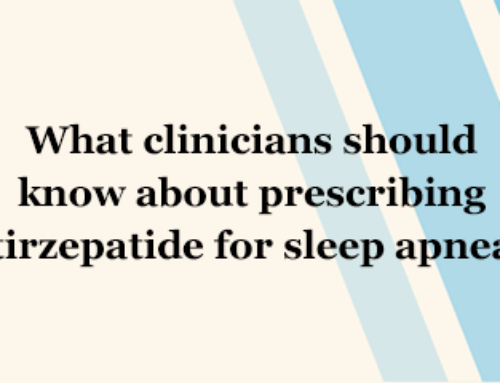By Kate Robards, Senior Writer
As the U.S. grapples with an ongoing obesity epidemic, new weight loss medications are quickly emerging as a treatment option, and they’re also showing promise as a potential intervention for obstructive sleep apnea (OSA).
Since 1990, the global prevalence of adult obesity has more than doubled. In the United States, the prevalence of obesity was 41.9% in 2017-2020, and predictive models suggest that will grow to one in two adults by 2030.
Obesity is linked to more than 40 other diseases, including heart disease, diabetes, stroke and certain types of cancer.
With concern mounting over rising obesity rates, weight loss drugs — including semaglutide and tirzepatide — are generating a buzz. These drugs, known as GLP-1 receptor agonists, are part of a new class of weight loss medications that are shaking up treatment of obesity and diabetes. The drugs decrease appetite and slow down the emptying of the stomach so people feel less hungry and eat less.
Semaglutide is known by the brand names Ozempic and Wegovy, while tirzepatide is sold under the brand names Mounjaro and Zepbound. The FDA approved Ozempic for people with diabetes in 2017 and Wegovy for those with obesity or who are overweight and have additional health problems in 2021. Similarly, Mounjaro is an antidiabetic medication, and Zepbound is approved for weight loss.
While the injectable medications work in similar ways to reduce appetite by activating hormone pathways in the body, there are differences. Ozempic and Wegovy are single-agonist drugs, while Mounjaro and Zepbound are dual-agonist drugs. Research indicates that the dual-agonist drugs may lead to more weight loss compared with drugs that activate a single hormone pathway. For example, a cohort study published July 8 in “JAMA Internal Medicine” found that use of tirzepatide was associated with significantly greater weight loss than semaglutide.
A brief history of weight loss medications
The five anti-obesity medications currently approved by the FDA for long-term weight management include three single drugs (liraglutide, semaglutide and tirzepatide) and two combination drugs (qsymia and contrave).
Despite their potential, anti-obesity drugs have a checkered past. Long before the newer drugs hit the market in recent years, a variety of anti-obesity medications have been released, only to be withdrawn due to safety concerns.
The appetite suppressant fenfluramine received FDA approval in 1996 but was terminated a year later due to evidence linking it to heart valve damage. Orlistat was linked to hepatotoxicity and adverse gastrointestinal events, sibutramine was associated with cardiovascular safety concerns, and lorcaserin was pulled from the market due to increased cancer risk.
Now more drugs are on the way. In July, Pfizer announced it is advancing development of a once-daily formulation of the oral GLP-1 receptor agonist danuglipron. Less than a week later, Roche announced positive topline results from two arms of an ongoing, multi-part, phase I clinical trial for CT-996, an investigational, once-daily, oral GLP-1 receptor agonist being developed for the treatment of both Type 2 diabetes and obesity.
Much remains unknown about the long-term effects of current weight loss medications, with even less known about how the drugs will impact sleep.
The link between obesity and sleep problems
There’s ample evidence that poor sleep is linked to a higher risk of weight gain and obesity, while being overweight can exacerbate sleep problems.
Rafael Sepulveda-Acosta, MD, is the medical director and CEO of Sleep Fit Medical, a practice that integrates evidence-based, patient-centered medical treatment for weight management and sleep disorders.
“Within my first years in medical practice, I developed curiosity on how to improve the support to patients with obesity besides just telling them to ‘lose weight,’” said Dr. Sepulveda-Acosta. “That curiosity was the origin of Sleep Fit Medical. Now, there are more tools for treatment and very strong evidence of the interplay between these two aspects of health with obesity being the root of many of our patients’ health challenges.”
Obesity medicine accounts for about 40% of Dr. Sepulveda’s practice.
Weight impacts an individual’s risk for OSA. Studies have found that a higher body mass index (BMI) is associated with greater OSA severity, while weight loss is associated with decreases in OSA severity.
“Obesity and sleep breathing disturbances like OSA often go hand in hand,” Dr. Sepulveda-Acosta explained. “Excess weight can lead to the accumulation of adiposity around the upper airway, which can obstruct proper breathing during sleep, resulting in OSA. Conversely, OSA can contribute to weight gain by reducing deep sleep, disrupting the sleep-wake cycle, and affecting hunger hormone regulation. This will lead to increased appetite and cravings for high-calorie foods. Consequently, weight management plays a crucial role in addressing sleep breathing disorders in patients with a higher BMI.”
Weight management plays a role in addressing a variety of sleep problems beyond just OSA. Obesity is associated with a variety of comorbidities that impact sleep, including depression, gastroesophageal reflux disease, arthritis pain, and asthma.
With weight playing a critical role in an individual’s sleep, it makes sense that medications like Wegovy and Zepbound could potentially alter the landscape of sleep medicine.
On the ‘Fast Track’ to treat sleep apnea
There is limited research on the effectiveness of weight loss medications for sleep apnea, but the landscape is rapidly changing.
While medications like Wegovy are not approved to treat OSA, it’s unsurprising that people with OSA who take it may experience an improvement in symptoms since weight loss can decrease OSA severity. A study published in 2016 found that liraglutide decreased the apnea-hypopnea index (AHI) by six episodes per hour more than with placebo.
In April, Eli Lilly announced positive topline results of a phase 3 clinical trial showing that tirzepatide significantly reduced the AHI compared with placebo. According to the company, tirzepatide achieved a mean AHI reduction of up to 63%, meaningfully improving symptoms in those with moderate-to-severe OSA and obesity with and without positive airway pressure (PAP) therapy.
Results of two phase 3, double-blind, randomized, controlled trials were published in the “New England Journal of Medicine” in late June. Comparing tirzepatide with placebo, the two studies found an estimated treatment difference of −20.0 events per hour and −23.8 events per hour, respectively. Overall, tirzepatide reduced the AHI, body weight, hypoxic burden, high-sensitivity C-reactive protein concentration, and systolic blood pressure, and it improved sleep-related patient-reported outcomes.
Lilly already has received FDA Fast Track designation for tirzepatide for moderate-to-severe OSA in patients with obesity. Following publication of these new study results, Lilly indicated that it anticipates the Food and Drug Administration will make a regulatory decision “as early as the end of this year.” Industry analysts expect that makers of other weight-loss drugs will soon turn their attention to OSA, too.
Considerations for clinicians
When weight loss medications are approved to treat OSA, clinicians will face a host of new challenges.
Importantly, little is known about the long-term implications of these treatments. Drugs like Ozempic and Wegovy have already been found to cause unpleasant gastrointestinal side effects, and rapid weight loss can produce sagging skin, which some have started calling “Ozempic face.” Additionally, patients are likely to need to continue using the medications long-term to maintain their weight; people who stop taking the drugs often gain the weight back quickly.
Beyond unknown risks, these newer medications may be cost prohibitive without insurance coverage. At recent list prices, the drugs may cost upward of $12,000 annually.
“Currently, the leading constraint is CMS and private insurance coverage for anti-obesity medications and care,” Dr. Sepulveda-Acosta said. “Hopefully, these challenges would change once payers start recognizing obesity as a chronic disease state such as diabetes or OSA.”
Additionally, when weight loss medications are approved for OSA treatment, it will necessitate a shift in the way sleep medicine professionals and specialists in endocrinology, diabetes and metabolism work together — eventually.
Raymond Bourey, MD, associate professor of medicine in the division of endocrinology at Washington University School of Medicine in St. Louis, has used GLP-1 analogues in combination with lifestyle changes and occasionally ENT procedures to get select patients with sleep apnea off PAP therapy and, in some cases, off anti-diabetic therapy since 2005.
“There are currently three barriers to more interaction between providers of sleep medicine services and specialists in endocrinology, diabetes, metabolism or weight loss clinics,” Dr. Bourey said. “First, there is little interaction among specialty societies outside of research and little interest in development of joint clinical guidelines. Second, diabetes and obesity treatment centers cannot yet get accreditation to use home sleep apnea tests to screen their patients for sleep apnea. Third, as endocrinology is the lowest paid specialty, the U.S. is now down to a few thousand board-certified specialists in endocrinology, diabetes, and metabolism to serve the more than 100 million patients who would benefit from subspecialty care – they’re simply hard to find, let alone work with.”
Despite these barriers, there may be a long-term need for an increased partnership between sleep medicine professionals and other specialists should weight loss medications continue to grow in popularity.
“If they are not doing it already, I encourage all my colleagues in sleep medicine to open up communication with the medical weight loss clinics and diabetes care centers,” Dr. Bourey added. “I estimate about 80% of patients would benefit from care by both sleep medicine and metabolism.”
Dr. Sepulveda-Acosta highlighted additional considerations for clinicians.
“If anti-obesity medications were to be approved for OSA treatment, clinicians would need to be aware that it’s vital to primarily address proper nutrition, tolerable physical activity, and identification of weight-modifying behaviors while using anti-obesity medications as complementary tools to treat obesity,” Dr. Sepulveda-Acosta said. “Additionally, vigilance and management of adverse effects or interactions with other weight-promoting medications is extremely important.”
Integrating sleep medicine and weight management
The intricate relationship between sleep, weight management, and overall health underscores the profound impact that each element has on the others.
“Due to the correlation between sleep and obesity, synchronized sleep and weight management care is essential to improve our odds of surpassing an adequate outcome to reaching an excellent outcome in our patients,” Dr. Sepulveda-Acosta said. “Addressing both aspects in a sustainable way is key to long-term health and well-being.”
Promisingly, emerging medications have the potential to play a role in treating OSA and improving sleep. However, the extent of their efficacy and safety remains uncertain. Ongoing and future clinical trials will be pivotal in providing evidence of long-term effectiveness to guide their integration into comprehensive sleep care strategies.





